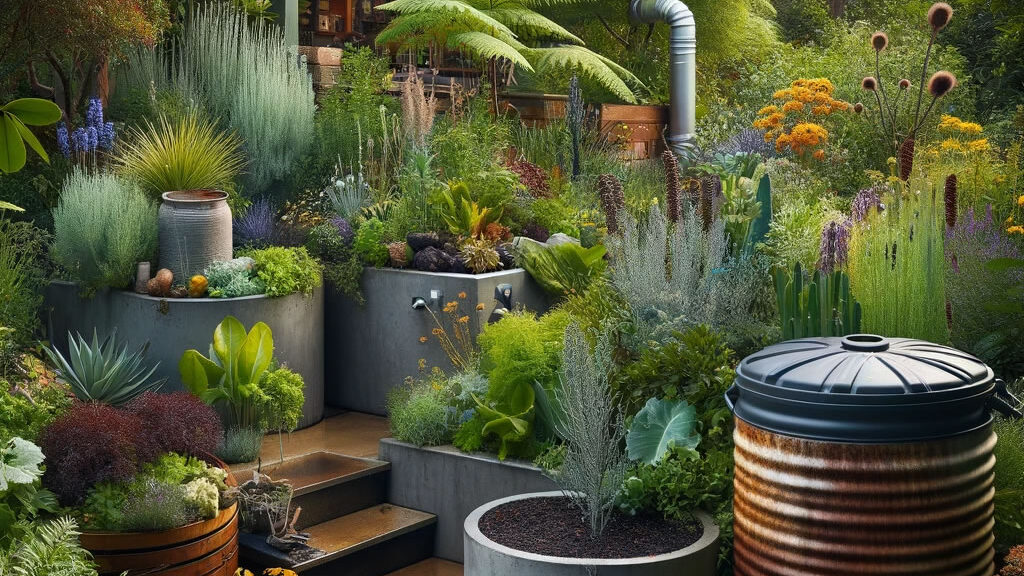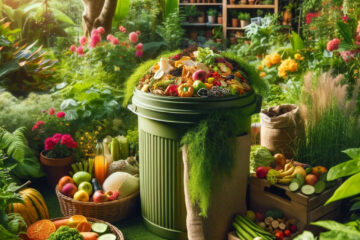Sustainable landscaping goes beyond simply planting a few trees and adding mulch to your garden beds—it’s an approach that involves creating an outdoor space that is in harmony with the local climate, soil, and wildlife.
This method reduces the negative environmental impact through the efficient use of resources, making your garden not just a beautiful space but also a functional one that contributes to the health of the ecosystem.
By adopting sustainability principles, you’re committing to practices that save water, require less maintenance, and support the surrounding biological community.
As you embrace sustainable landscaping, you turn your attention to techniques that promote biodiversity and reduce waste. This includes choosing plants that are native to your region, which are more likely to thrive with minimal water and fertilizer.
By integrating sustainable garden ideas, you ensure that there are blooms that provide habitat and food for pollinators throughout the seasons, creating a vibrant and self-sustaining ecosystem.
Incorporating green landscaping ideas into your yard also implies eco-friendly practices such as organic pest management, composting, and the thoughtful use of materials.
By selecting environmentally friendly hardscape options and reducing lawn areas, you cut down on the need for watering and chemical interventions.
Sustainable landscaping is a thoughtful process, but by incorporating these principles, you can create a garden that not only looks good but is also good for the planet.

Table of Contents
Fundamentals of Sustainable Gardening
Sustainable gardening pivots on understanding how to nurture your garden’s resources, particularly soil and water, while selecting appropriate vegetation that thrives with minimal inputs.
Understanding Soil Health
Soil health is the foundation of a thriving garden ecosystem. Assess your soil condition by examining its texture and nutrient content—this will inform which amendments and practices will best support your plants.
Adding organic matter, such as compost, can greatly improve soil structure and fertility. Remember, healthy soil supports plants better, making them more resilient to pests and diseases.
Importance of Water Conservation
Water conservation is critical in sustainable gardening. Implementing drip irrigation systems minimizes water loss by delivering water directly to the plant roots.
Consider rainwater harvesting to collect and use rainwater for your garden.
Not only does this practice conserve water, but it also lessens the demand on the municipal water supply, which is especially important during droughts.
Selecting Drought-Resistant Varieties
Choose drought-resistant plants that are well-suited for your garden’s sunlight exposure and climate.
These varieties require less water and are more tolerant of low-water conditions.
By selecting the right plants, you not only conserve water but also reduce the need for chemical interventions, promoting a more eco-friendly garden.
Designing an Eco-Friendly Garden
When you aim to create a garden that harmonizes with the local ecosystem, focus on choosing elements that sustain native biodiversity and minimize environmental impact.
Let’s explore specific ways to make a positive difference through sustainable landscaping.
Incorporating Native Plants
Incorporating native plants into your garden is crucial for several reasons.
These plants are adapted to your local climate and soil conditions, which means they require less water, are more resistant to local pests, and promote local biodiversity by providing essential habitats for nearby wildlife.
For example, a flowering native perennial could attract and support pollinating insects that are vital for the health of your garden’s ecosystem.
- Benefits of Native Plants:
- Lower maintenance
- Reduced need for water and fertilizer
- Support local wildlife and pollinators
- Enhance biodiversity
Implementing Companion Planting
Companion planting is a method where you strategically place plants next to each other to mutually benefit them, such as deterring pests or enhancing soil nutrients.
By following this method, you can boost the productivity and health of your garden without the use of harmful chemicals, making your garden more eco-friendly.
Tomatoes, for instance, can thrive when planted near basil, as the herb naturally repels certain insects that could harm tomato plants.
- Examples of Companion Planting:
- Tomatoes with basil
- Carrots with onions
- Cucumbers with sunflowers
Establishing Wildlife Habitats
To enhance the biodiversity and resilience of your garden, focus on creating areas that offer shelter, food, and water to various forms of wildlife.
Structures such as birdhouses, small ponds, and logs can create nurturing environments for different species.
Establishing wildlife habitats also means considering features such as water sources, like birdbaths or a native plant garden, which support a diverse range of visiting fauna.
|
|
| |||
|
|
| |||
|
|
| |||
|
|
|
Maintaining Your Garden with Ecological Practices
In sustainable landscaping, maintenance practices are as vital as the design itself. Adopting ecological methods such as using organic mulch and employing manual tools can significantly improve the health of your garden while reducing environmental impact.
Adopting Organic Mulching Techniques
Using organic mulch not only retains soil moisture and regulates temperature but also reduces the need for chemical fertilizers.
Apply a layer of mulch, like straw or wood chips, around your plants to keep weeds at bay and to add nutrients back to the soil as it decomposes.
Remember to keep mulch away from plant stems to prevent rot.
- Types of Organic Mulch:
- Compost
- Grass clippings
- Shredded leaves
- Straw
Using Natural Pest Control Methods
Incorporate natural pest control techniques to minimize the use of harmful pesticides.
Introducing beneficial insects, like ladybugs and lacewings, can help control pest populations.
For a DIY approach, create garlic or chili pepper sprays to deter pests without harming your plants.
- Beneficial Insects:
- Ladybugs
- Lacewings
- Praying mantises
Employing Manual Tools and Electric Mowers
Reduce your carbon footprint by using manual tools and electric mowers.
Manual tools, such as hand pruners and rakes, allow precision work without the need for fuel.
Electric mowers, while requiring energy, emit no pollutants and are quieter than their gasoline counterparts.
- Advantages of Electric Mowers:
- No emissions
- Quieter operation
- Less maintenance than gas mowers
By focusing on these ecological practices, your garden maintenance can align with sustainable principles, leading to a healthier ecosystem within your own backyard.
Reducing Environmental Impact
In sustainable landscaping, your primary aim should be to lower your garden’s carbon footprint and reduce waste.
This involves conscious decisions like recycling materials, minimizing lawn space, and avoiding synthetic fertilizers.
Recycling and Using Recycled Materials
Recycling isn’t just for your kitchen; it plays a critical role in your garden too.
You can reduce waste by using recycled containers for potting plants and repurposing objects like old furniture as garden accents.
Embracing recycled materials doesn’t just minimize landfill contributions, it also adds character to your garden.
- Recycling: Use compost to transform kitchen and garden waste into rich soil.
- Recycled Materials: Opt for garden structures made from recycled plastic or metal.
Minimizing Lawn Space
Lawns, while popular, have a significant environmental impact due to their water and maintenance requirements.
Shrink your lawn size to create room for ground cover plants, which require less upkeep and are often more beneficial to local wildlife.
Reducing the size of your lawn also means lower emissions from lawn mowers and less use of fertilizers.
- Ground Covers: Choose native plants that provide similar benefits with less maintenance.
- Lawn Alternatives: Utilize synthetic turf or hardscaping materials in high-traffic areas.
Avoiding Chemical Fertilizers
To mitigate the harmful effects of chemical fertilizers, switch to organic alternatives which are gentler on the earth and often less expensive in the long term.
Chemicals can leach into waterways, whereas organic fertilizers improve soil health and structure, making plants more resilient and reducing the need for future inputs.
- Organic Fertilizers: Enrich your soil with earth-friendly compost or manure.
- Soil Health: Integrate practices like crop rotation and mulching to enhance fertility naturally.
Innovative Techniques in Sustainable Landscaping
As you strive for a more eco-friendly garden, innovative techniques in sustainable landscaping become crucial.
These methods not only enhance the appeal of your outdoor space but also contribute positively to the environment.
Exploring Xeriscaping and Rainwater Runoff Management
Xeriscaping is a landscaping philosophy that reduces or eliminates the need for supplemental water from irrigation.
It’s particularly useful in arid regions. By utilizing drought-resistant plants and mulches, you can create a garden that thrives with minimal water.
For instance, use plants native to your region as they are adapted to local rainfall patterns and soil conditions.
When addressing rainwater runoff, consider installing permeable pavers or a rain garden to enhance filtration.
Systems like swales or French drains can channel rainwater runoff, allowing it to seep back into the soil, replenishing groundwater and preventing erosion.
Creating Living Walls and Green Spaces
Living walls, also known as green walls, are not only visually stunning but also functional elements in sustainable landscaping.
They provide natural insulation, reduce heat island effect, and improve air quality by filtering pollutants.
Choose a variety of plants for your living wall that serve different purposes, like succulents for drought tolerance and ferns for moisture-rich areas.
In the pursuit of sustainable landscaping ideas, don’t overlook the potential of green spaces to promote biodiversity.
Create habitats for local wildlife by including native species, birdbaths, and bee hotels. These efforts support a balanced ecosystem right in your backyard.
Frequently Asked Questions
In this section, you’ll find targeted advice on creating and maintaining an eco-conscious landscape that aligns with principles of sustainability, from design to day-to-day practices.
How can I design a landscape that benefits the environment?
To design an environment-friendly landscape, consider incorporating native plants that require less water and are more resistant to local pests.
Evaluate your land’s natural layout and work with it to minimize soil erosion and water runoff. For inspiration and practical tips, see Getting Started with Sustainable Landscaping: Tips from the Field.
What practices do sustainable landscaping companies follow to be eco-friendly?
Sustainable landscaping companies focus on practices such as using organic fertilizers, installing efficient irrigation systems, and employing electric or manual tools instead of gas-powered ones to reduce air pollution.
What are some examples of eco-friendly materials to use in sustainable landscaping?
Eco-friendly materials include decomposed granite for pathways, which is permeable and reduces runoff, and mulch from recycled plant material, which conserves water and suppresses weeds.
How can I maintain a garden in a manner that supports sustainability?
Support sustainability in your garden by choosing drought-tolerant plants, collecting rainwater for irrigation, and adopting natural pest control methods.
To save water, you can also reduce the lawn area and replace it with groundcovers that demand less maintenance and water.
What are key design principles to adhere to in sustainable landscape architecture?
Key principles include using native plants, creating habitats for local wildlife, conserving water through smart design, and using sustainable materials.
Each design should aim to minimize environmental impact and create a space that thrives with minimal human intervention.
How can a landscape design contribute to local wildlife and biodiversity?
A landscape design contributes to local wildlife and biodiversity by including a variety of native plants that provide food and habitat, integrating water sources like bird baths or small ponds, and avoiding chemicals that harm beneficial insects and wildlife.




[…] herbs that have a variety of uses and can thrive in your local climate aids in an enjoyable and sustainable gardening […]
[…] you’re just starting out with flower gardening, there are a few essential tips to keep in […]